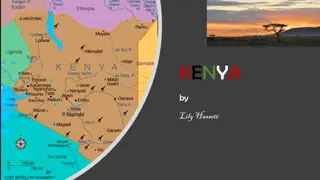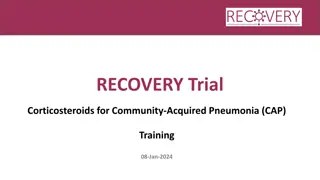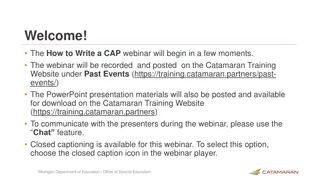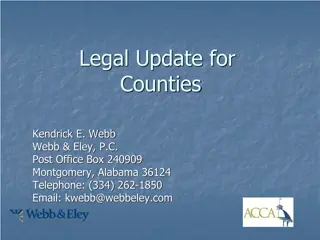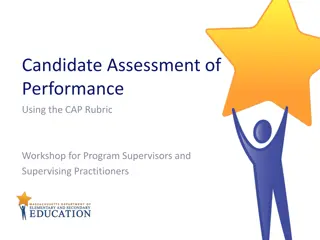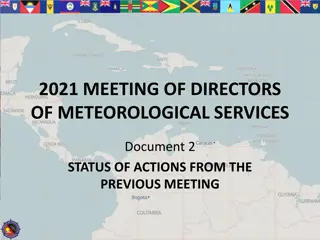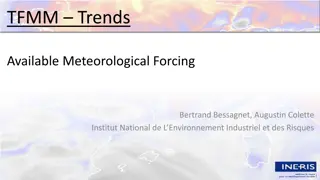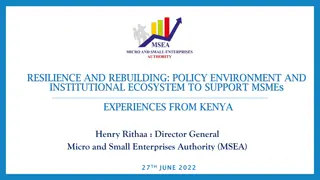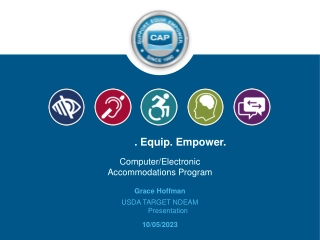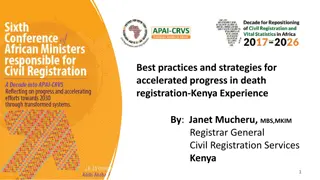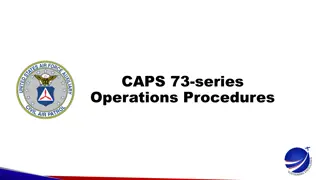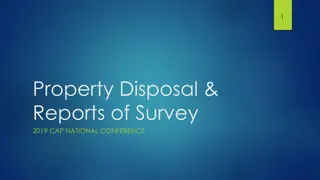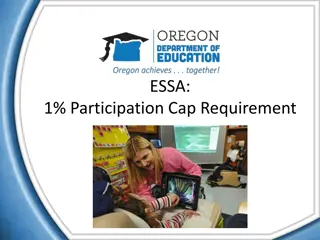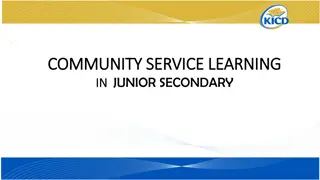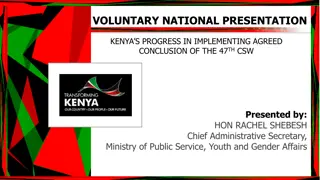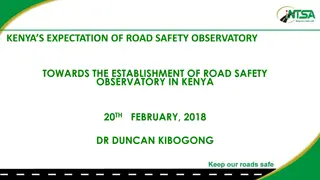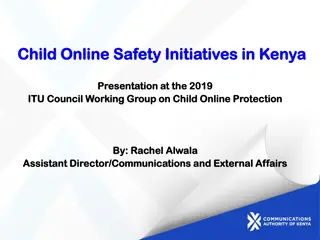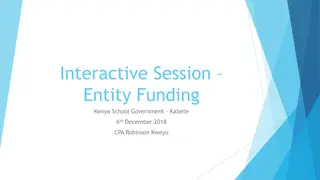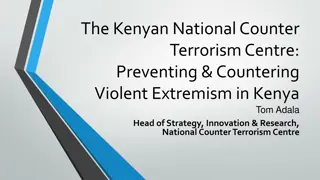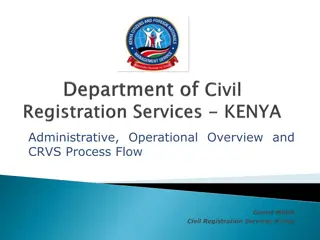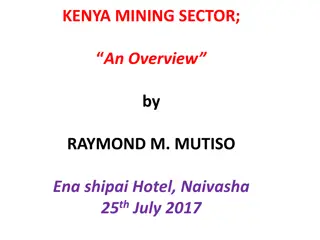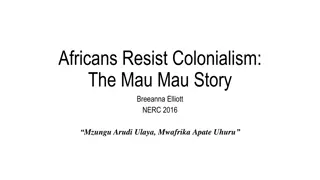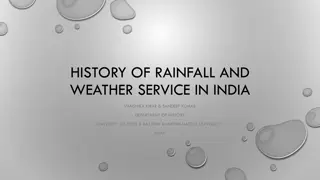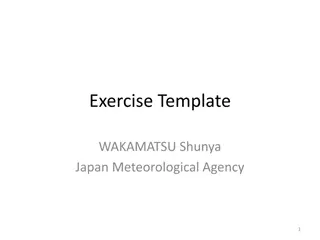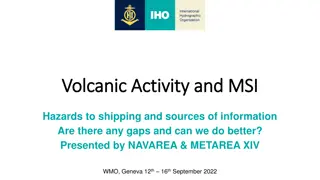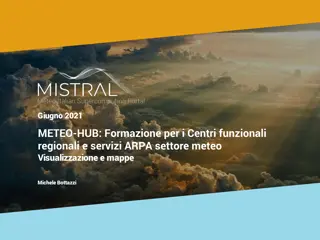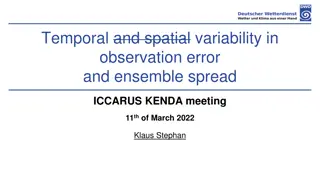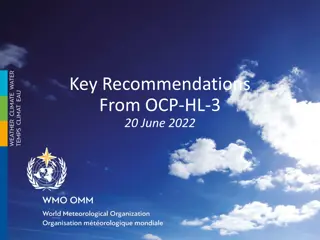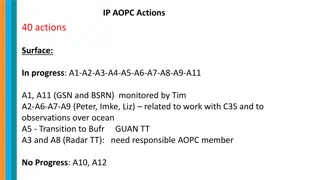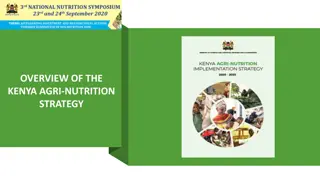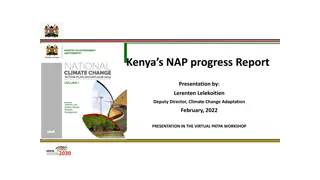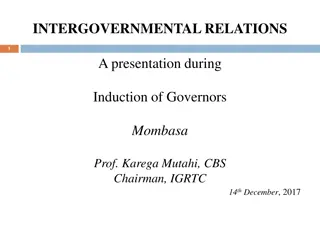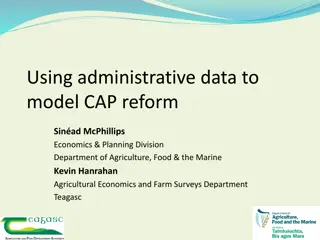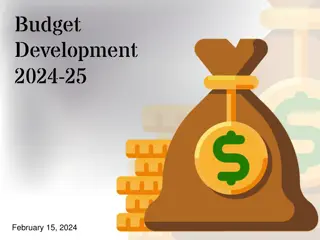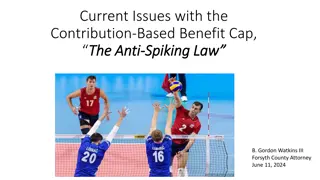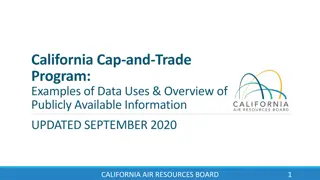Implementation Experiences of CAP by Kenya Meteorological Department
Kenya Meteorological Department (KMD) has been implementing the Common Alerting Protocol (CAP) since late 2012 to enhance the production and dissemination of weather advisories and warnings. KMD is responsible for generating weather alerts, identifying threat events, and classifying messages based on severity levels. The department is focused on integrating manual and automatic systems for efficient CAP message formatting and delivery, ensuring safety and preparedness for various weather conditions in Kenya.
Download Presentation

Please find below an Image/Link to download the presentation.
The content on the website is provided AS IS for your information and personal use only. It may not be sold, licensed, or shared on other websites without obtaining consent from the author. Download presentation by click this link. If you encounter any issues during the download, it is possible that the publisher has removed the file from their server.
E N D
Presentation Transcript
KENYA METEOROLOGICAL DEPARTMENT CAP Implementation Experiences in Kenya Presented by Roger Ndicu Principal Meteorologist Public Weather Service
Introduction KMD is responsible for the organization and operational management of meteorological services in Kenya; Mandated to generating Weather Advisories, Alerts & Warnings; CAP was introduced to KMS in late 2012; KMD has been working on an integrated solution to Advisories/Warning production & dissemination of alert messages; This integrated solution will target CAP message format and manual and automatic systems
Threat Events Identified (1) (Forecasts Generated from SWFDP Products & Others) THREAT EVENT Heavy Rainfall & Storms Wave Heights (Indian Ocean) Wave Heights (Lake Victoria) Hot Conditions Cold Conditions Strong Wind & Gusts (Wind Speed) Bundalang i Flood Plains Advisory Issued Planned Planned Planned
Threat Events Identified (2) (Forecasts Generated from SWFDP Products & Others) THREAT EVENT Agricultural Drought (more than 10 15 days dry spell) Health Advisory Tsunami warning Thick Fog Lightning Hailstorm Frost Advisory Issued Not yet Planned but Not yet Planned but Not yet Not yet Not yet Not yet Not yet
Color Code Message Matrix (Based on both Severity & Urgency) Forecast Period Extreme Severe Moderate > 3 Days 2 Days 1 Day To make Message classification much simpler and workable we have set our basis on an event or intensity of events in 24hrs
Classifying Messages (Based on a Severe or Extreme Event) Threa t Levels Color Code General Message Details A message issued to inform vulnerable population of weather threats that take time to arrive. Watch Weather conditions impact on the population in ways that are not a direct threat to life and property but ignoring it may lead to hazardous conditions. Advisory A threat is imminent with little time for preparation and quick action is needed Alert A message issued when a threat is occurring or imminent, and immediate action to evacuate is needed Warning
Classifying Messages (Based on a Severe or Extreme Event) Threa t Levels Color Code Lead Time <urgency> value in CAP > 3 Days Future Watch 3 Days Expected Advisory Alert Expected 2 Days Warning Immediate or Expected < 1 Day
Classifying Messages in CAP (Based on Severity in a 24 hr forecast Message) Color Code in PDF <severity> <severity> value in CAP value in CAP Message Advisory Moderate Alert Severe Warning Extreme
Ranking Events in CAP (1) Event Thresholds Rank Alert Name for Public Display Very heavy Rain / Storm Rainfall of >100mm in less than 24 hours 1. Heavy Rain / Storm Rainfall of >50mm in less than 24 hours 2. Heavy Rain Rainfall of >30mm in less than 24 hours 3. Very Strong Wind Surface Wind speeds of > 30 knots 1. Strong Wind Surface Wind speeds of >25 knots 2. Very High Wave Wave heights of more than 3 meters 1. High Wave Wave heights of more than 2 meters 2.
Ranking Events in CAP (2) Rank Event name for public display <event> value in CAP <severity> value in CAP <certainty> value in CAP Very heavy Rain / Storm Heavy Rain Alert Extreme Likely, Possible 1. Heavy Rain / Storm Heavy Rain Advisory Severe Likely, Possible 2. Heavy Rain Heavy Rain Advisory Moderate Likely, Possible 3. Very Strong Wind Strong Wind Alert Severe Likely, Possible 1. Strong Wind Strong Wind Advisory Moderate Likely, Possible 2. Very High Wave State of the Sea Severe Likely, Possible 1. High Wave State of the Sea Moderate Likely, Possible 2.
Classifying Messages in CAP (Based on the likelihood of a Severe or Extreme Event occurring) Probability of Occurrence <Certainty> value in CAP More than 66% Very Likely Between 33% and 66% Likely Possible Less than 33% Unknown Less than 33% (With lead time more than 3 days)
Publishing CAP Messages (In our Website) Link to PDF Messages Link to CAP Messages & Feeds
Creating A Customized Template (For use in the <description> field in CAP Message) For example, for heavy rainfall Event in Nairobi county <severity> value in CAP <description> value in CAP Very heavy rainfall and storms may result in flash floods and many housing estates may be cut off. Extreme Heavy rainfall may result in flash floods and some housing estates may be cut off Severe Heavy rainfall may result in pools of water appearing in some places. There is a chance of flash floods occuring in some places Moderate
Online Training in CAP in the WMO moodle An initiative of the UK Met Office, WMO and KMD Objective is to enable Meteorologists compose warning messages and issue CAP alerts. Already developed a lesson plan and a storyboard for the online training.
Online Training in CAP in the WMO moodle By the end of the training session the student will be able to: Describe Common Alerting Protocol message from a broad perspective. Describe and understand the CAP message format and structure Compose a CAP message alert/warning Create own message description template for use in the CAP message <description> field
Working with Google Public Alerts(1) (RSS feeds to this website)
Working with Google Public Alerts(2) Started a process with Google More than 10 countries provide content to Public Alerts Page Has the infrastructure Has the experience and bigger viewership Google Page is compatible with CAP format Google is eady to assist in CAP development
Working Local Mobile Networks (CAP Message in XML format to Networks) CAP Message (Due to its geospartial Character, it can be disseminated to an audience in a specific target area through the mobile phone)
Potential CAP community in Kenya Authority Just started Ongoing Min. of Health Min. of Agriculture Min. of Water National Disaster Operation Centre Red Cross (Kenya) Kenya Maritime Authority Kenya Ports Authority National Drought Management Authority
Problems & Challenges Classification of Messages Message structuring for CAP Setting thresholds / Ranking Events Encouraging a cross agency communication thro CAP Distributor Licensing Language Translation
Way Forward Activity Just started Ongoing Complete CAP Structuring Creating a Template of CAP customized content CAP online training in the Moodle CAP training locally Working with Google Public Alerts Page Working with Local Mobile Networks


